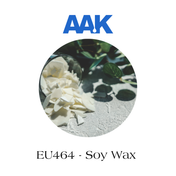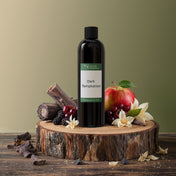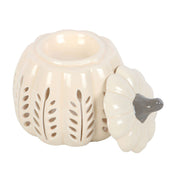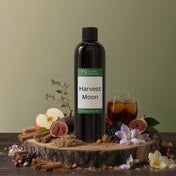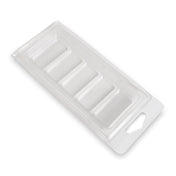Candle-making has always been a dance between tradition and innovation. And in recent times, one particular star has been lighting up the candle stage: soy wax. Its rise isn’t just because of a passing trend—it’s anchored in genuine, tangible benefits that both candle-makers and their customers adore.
Now, if you've found yourself curious about this plant-based powerhouse or are completely new to making homemade candles, you've landed in the right spot. With its eco-friendly credentials and superb burn quality, soy wax has not only won the hearts of seasoned crafters but also those venturing into this art for the first time. Read on to uncover why soy wax is becoming a staple in every candle-maker's toolkit.
What is soy wax?
Let's chat about natural soy wax. It's made from soybeans, and, compared to its counterpart, paraffin, these types of candles have the edge with a cleaner burn and longer life. But a little heads-up: while soy is a renewable resource, many soy crops rely on GMOs and some chemicals to help boost crops.
On the bright side, soy wax is biodegradable. Every time you light a soy candle, you're enjoying a balance of nature and modern practices. There's always more to the story, and it's good to be in the know.
Why do candle-makers love soy wax?
Every artisan seeks candle supplies that enhance their craft and resonate with their vision. For keen candle enthusiasts, soy wax is often that elusive perfect ingredient. But what makes it so special?
First off, its burning properties are truly commendable. Soy wax burns cooler, which means your candles have a longer lifespan compared to those made from other waxes. That gentle, steady burn? A hallmark of quality soy wax candles. It doesn’t just stop at longevity. The cooler burning temperature ensures an even melt pool, helping distribute fragrance uniformly throughout the room.
And speaking of fragrance, soy wax has an impressive scent throw. Whether you're crafting a vibrant citrus burst or a calm lavender embrace, soy wax ensures that every note reaches its full aromatic potential. Another endearing feature of soy wax is its forgiving nature. Make a little mistake while crafting? Soy wax is easy to clean, allowing for tweaks and adjustments even after the wax has set.
The pros and cons of soy wax

While you may be sold on soy wax by now, like every crafting material, it has its shining moments and its occasional challenges. Let's weigh in on what makes soy wax stand out and the things to keep an eye on.
Pros:
Clean burn: One of the primary reasons candle makers adore soy wax is its clean burning property. When wicked correctly, you can expect no more black, sooty residue on your jars or walls, ensuring a cleaner burn.
Sustainability: Soy wax is derived from renewable soybeans and is biodegradable (which we consider a pro).
Texture: The creamy, smooth texture of soy wax provides a high-quality finish, making candles look just as luxurious as they feel.
Fragrance retention: Soy wax holds onto fragrance oils beautifully, ensuring a delightful scent throw both when the candle is lit and when it's not.
Cons:
Potential frosting: One of the quirks of soy wax is frosting, a powdery white layer on candles. While harmless and often considered a sign of pure soy, it might not be the aesthetic everyone desires.
Specific fragrance requirements: Keep in mind that soy wax can be a tad selective when it comes to fragrance oils. Some scents may not blend perfectly, so you might need to pick carefully and tweak concentrations as needed.
Slower fragrance diffusion: Though soy wax retains fragrance superbly, it might release the scent slower than its paraffin counterparts, demanding patience from eager noses.
Not organic: Unless specifically stated, most soy waxes are not organic and the majority of soy crops involve GMOs and the use of certain chemicals to help boost harvest. Soy is still a superior choice in our opinion but it is important to be aware of this fact.
As you start to experiment with soy in the making process, being aware of these pros and cons ensures you're prepared for every step and can craft candles that truly resonate with your vision. You can also check out our handy wax comparison guide to weigh up your options with other wax types.
The best soy wax for your candles
Choosing the perfect wax for your candles is just like an artist selecting their palette—it shapes the final masterpiece. With the myriad of options available, you might find yourself wondering, “What is the best soy wax to use to make candles?” Let's simplify this for you.
Sourcing soy wax
When it comes to obtaining high-quality soy wax, many professionals and hobbyists alike turn to purchasing in bulk. Buying soy wax in bulk not only offers a cost-effective solution but also ensures a consistent supply for your candle-making projects.
Comparing soy wax types
Different soy waxes come with unique properties, primarily dictated by their intended use and subsequent melting points. The soy wax melting point can influence how the candle burns, its scent throw, and even the overall look of the candle.
Container Wax (Low melting point)
Typically melting between 46°C to 54°C, this type is ideal for container candles. It offers a softer texture and smooth finish, the wax is generally considered too soft for use in other applications.
Container Wax (Medium melting point)
With a melting range of 54°C to 65°C, this variant is versatile and can be used for both container candles and moulds. It boasts a slightly firmer texture making it a good all rounder wax, however, do bear in mind that it is still too soft for use in pillar candles.
Pillar Wax (High melting point)
Melting at temperatures above 65°C, this type is best suited for moulded candles, like pillars. They provide a hard finish, ensuring the candle retains its shape. Generally, these waxes are considered too hard for container candles, as the wax pulls away from the vessel during setting resulting in wet spots.
In essence, the best soy wax for your candles truly depends on the type of candles you're aiming to create. By understanding the nuances of each soy wax type and its melting points, you can craft candles that are not only beautiful but also efficient in burn and scent.
Crafting tips and best practices
Venturing into the world of candle crafting with soy wax? Brilliant choice! But as with any craft, there are nuances to master. So, whether you're a seasoned candle artisan or just starting, these tips and best practices will ensure your candles are the best they can be.
The perfect pour temperature
A common question many have is, "what temperature to pour soy wax?" The answer can vary based on the specific soy wax blend, but a good rule of thumb is to pour between 60°C to 70°C. This range typically ensures a smooth top and promotes a strong bond to the container.
Clearing the air—is soy wax toxic?
Let's address a common candle conundrum head-on. Many wonder, "Is soy wax toxic?" Rest easy, crafting enthusiast! Made from the oil of soybeans, soy wax is a natural, renewable resource. So, when you light up a soy wax candle, you're illuminating your space with a more eco-friendly option.
Recognizing soy’s place in the candle market
When it comes to soy wax for candle making, it’s not just about trends—it's about understanding its valuable properties. Soy wax delivers a longer, cleaner burn and tends to capture and release fragrance oils beautifully. So, when crafting, remember that you're working with a wax that has carved out its special niche in the candle-making arena. Hint: Use this as a selling point for your candle business!
Crafting perfect soy wax melts
There's an undeniable charm to candles, but have you ever been enchanted by the simplicity of soy wax melts? These little scent-packed wonders can transform your space with their intense fragrance, and crafting them with soy wax has its own set of compelling advantages.
Why soy wax for melts?
Soy wax is known for its clean burn, but when used in wax melts, there's no 'burn' at all—just a gentle melting that releases the fragrance. The result? A purer scent throw without the concern of soot or toxins. When making melts, be sure to use a melt or tart blend wax for your makers, these beauties are specially designed to ensure a consistent melt and a longer-lasting fragrance experience.
The right amount of fragrance
One of the essential elements of creating captivating soy wax melts is nailing the fragrance. But how do you determine the correct quantity? When considering how much fragrance oil for candles and wax melts, a common guideline is to use between 6% to 10% fragrance oil.
For precision, if you're working with 100g of soy wax, you'd typically want to add between 6g to 10g of fragrance oil, ensuring a potent scent throw while maintaining the integrity of the wax.
Crafting the melts
- Start by melting the soy wax, ensuring a smooth, lump-free consistency.
- Once fully melted, reduce the heat and add your chosen fragrance oil, mixing thoroughly.
- Pour the wax into moulds, allowing them to cool and set completely.
-
Once set, they're ready to be used in your wax melt burner!
So, soy wax melts aren't just about the scent; they're about the experience. When you get the blend just right, your melts will help set the mood and create warmth in every nook and cranny of a room.

The final flicker
As we dim the lights on our soy wax exploration, it's clear why this ingredient has cast a spell over candle makers globally. Its roots in nature, clean-burning profile and knack for delivering memorable fragrant punches make it a wax worth wagering on. It really is a no-brainer for blooming business owners!
From those sourcing soy wax in bulk across the UK, Europe and further afield, to the curious beginners questioning its toxicity, the allure of soy wax remains undeniable. Every time you light a soy candle or let a soy wax melt waft its aroma through your space, remember the intricacies and craftsmanship behind that subtle glow. With every flicker, there's a story of sustainability, artistry and a love for crafting.


